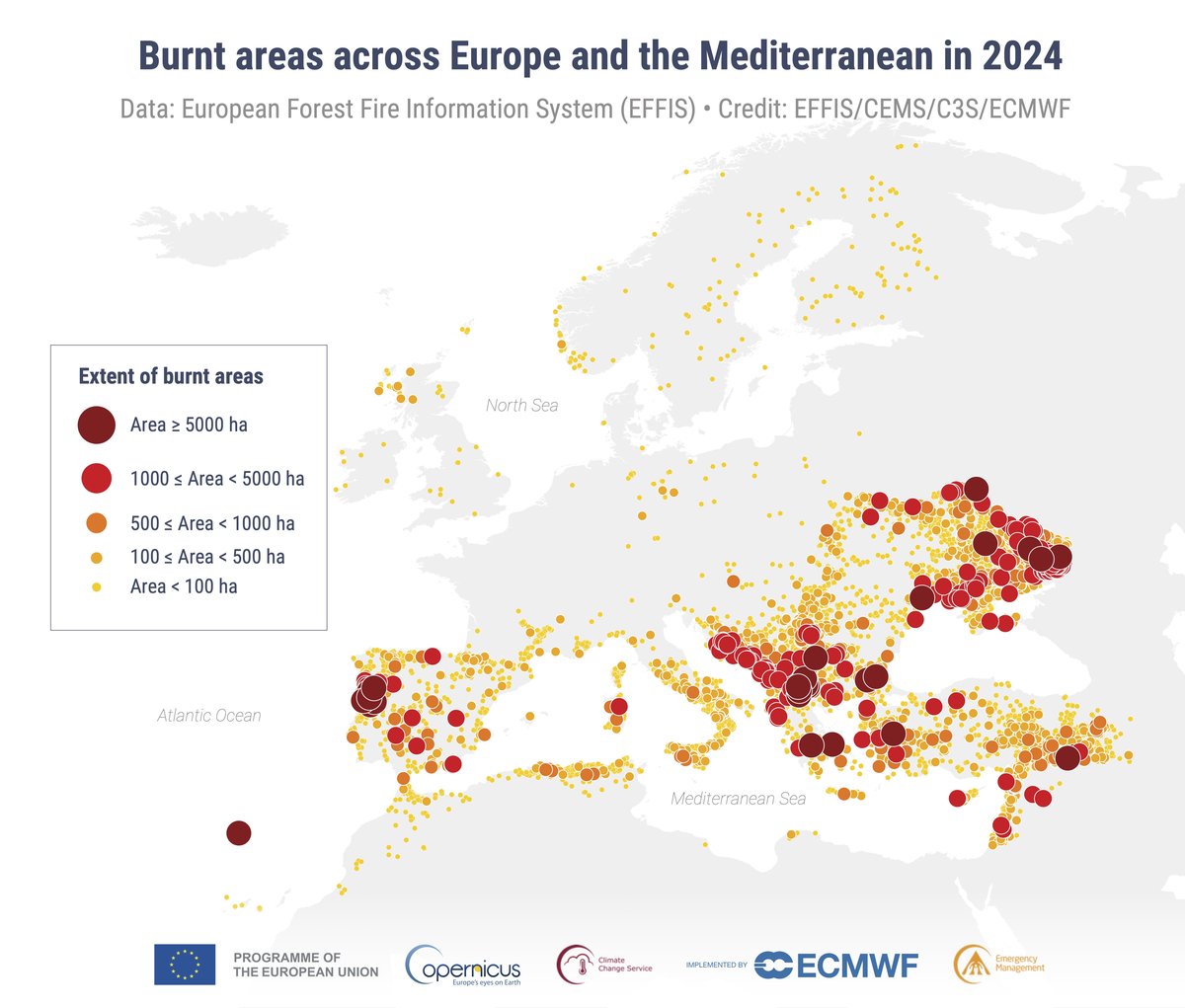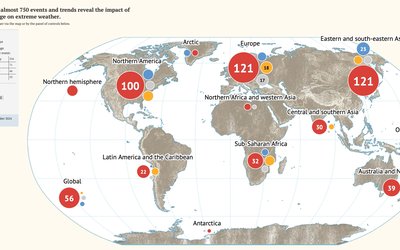
Map: Distribution and extent of burnt areas across Europe and the Mediterranean in 2024 (Credit: EFFIS/CEMS/C3S/ECMWF).
In 2024, Europe experienced its warmest year on record. Ocean, sea and lake temperatures were the highest ever recorded, heat stress increased further, and floods and wildfires hit Spain and Portugal. These are some of the key findings in the report European State of the Climate 2024.
About storms and flooding
In 2024, storms and flooding affected an estimated 413,000 people in Europe, resulting in the loss of at least 335 lives. Damage from storms and flooding across Europe during the year is estimated to have cost at least €18 billion. Western Europe saw one of the ten wettest years on record and Europe experienced the most widespread flooding since 2013.
An extreme rainfall event in Valencia, Spain, led to flooding causing at least 232 casualties in Valencia and several more in other provinces, and infrastructure damage and economic losses totalling around €16.5 billion. Daily rainfall reached a maximum of 771.8 mm, the second highest amount on record for Spain.
One of the most damaging widespread floods on record in Europe occurred in September 2024 due to Storm Boris, affecting eight countries in central and eastern Europe. The worst flood in Bosnia and Herzegovina since 2014 occurred in early October.
About wildfires
Around 400,000 ha burnt in Europe in 2024, which is slightly above average but 66% less than the record of 1,200,000 ha in 2017. 130,000 ha burnt in Portugal, representing 32% of Europe’s total burnt area.
About heat stress and health
2024 was Europe’s warmest year since 1900. The number of heat stress days and tropical nights – with minimum temperature above 20°C – was the second highest on record, and is increasing. The number of ‘cold stress days’ was the lowest on record.
Southeastern Europe experienced a record 23 tropical nights, far exceeding the average of eight and the previous record of 16, in 2012. However, the numbers were much higher in parts of this region: up to 55 more tropical nights than average in parts of Greece, up to 50 more in much of Italy, up to 40 more in western Türkiye, and up to 35 more in parts of Croatia, Serbia, Hungary, Romania and Bulgaria.
The area experiencing tropical nights has also been increasing from an average of around 20% of Europe seeing at least one tropical night per year in the 1970s, to around 34% in the 2010s and 35% so far in the 2020s.
In recent decades, heat has been the leading cause of reported deaths due to extreme weather and climate events in Europe. Heat-related deaths in Europe are estimated to be around 47,700 and 61,700 in 2022 and 2023, respectively.
About the oceans
For the European region and for the Mediterranean Sea, the annual sea surface temperature was the highest on record. Record‑high annual sea surface temperatures were observed in the central North Atlantic Ocean, the eastern Mediterranean Sea and Black Sea, and in the Norwegian Sea and the eastern Barents Sea.
The Mediterranean Sea as a whole experienced its warmest year on record, at 21.5°C, 1.2°C above average and 0.3°C higher than the previous record set in 2023. Daily sea surface temperatures averaged across the entire Mediterranean Sea reached their highest recorded value at 28.7°C, surpassing the previous record of 28.3°C set in July 2023.
About the lakes
The average surface water temperature for the warm season of the 267 European lakes was the highest on record, at 0.77°C above the average for 1995–2020. European lakes are warming at a rate of around 0.34°C per decade, which is faster than the global rate of around 0.22°C per decade.
About the glaciers
Central Europe, including the Alps and Pyrenees, is one of the regions of the world where glaciers are receding the fastest. Average ice thickness loss in the Alps in 2024 was 1.2 m. Although large, this is considerably less than the extreme losses observed in 2022 (3.6 m) and 2023 (2.4 m).
Glaciers in Scandinavia and Svalbard saw their highest recorded annual rates of mass loss in 2024, with an average ice thickness loss of 1.8 m in Scandinavia and 2.7 m in Svalbard. These regions also saw the largest annual mass loss of all glacier regions globally.
About renewable energy
The year saw a record proportion of electricity generation by renewables, at 45%.
Source: Copernicus Climate Change Service (C3S) and World Meteorological Organization (WMO), 2025. European state of the climate report 2024.








